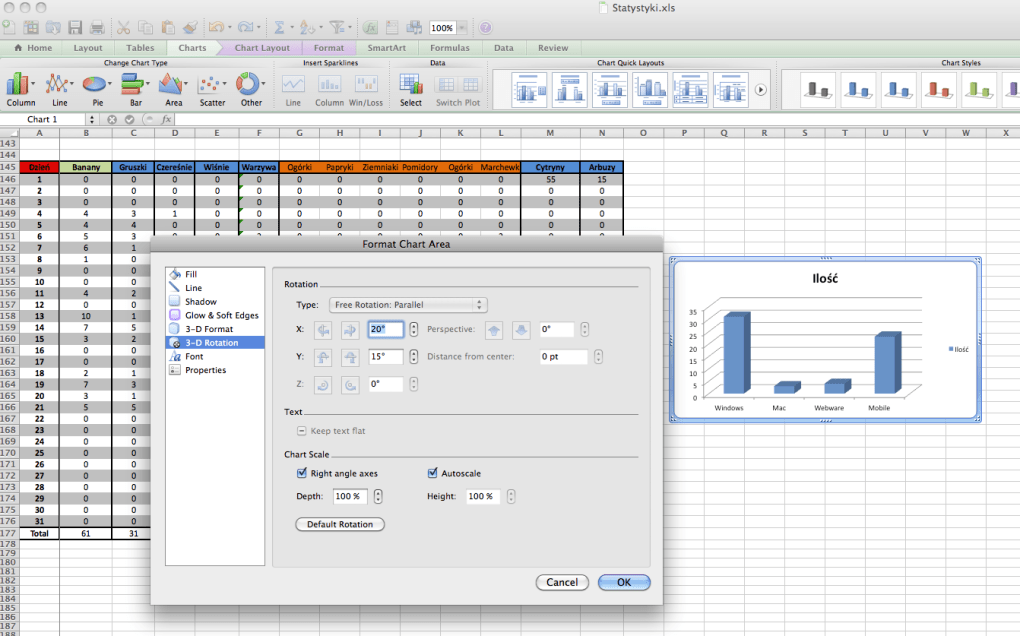
The Web version’s features are nowhere near as extensive as the desktop version’s, but most of the basics are there. In my test of this feature, it worked well enough.

Multiple people can even edit the spreadsheet at the same time, similar to the way you can collaboratively edit a Google Docs spreadsheet. With the Web application, you can edit your worksheet, and open the modified copy in Excel on your Mac. Once you’ve saved your documents to SkyDrive, you can access and edit them online, from any browser, using the Excel Web App.
2011 excell for mac windows#
If your sharing needs are simpler, you can save directly to Windows Live SkyDrive (free 25GB of storage) from within Excel 2011.
2011 excell for mac full#
These features match the protection options available in Windows versions of Excel, making for better cross-platform compatibility.īeyond enhanced worksheet protection, Excel 2011 offers full information rights management, which allows users in a corporate environment to specify users and groups of users with rights to a workbook, including restricting who can read, print, forward, edit, or copy its contents. You can also allow or prevent insertion and deletion of rows and columns, use of filters and sorting, and more. Creating sparklines is as easy as selecting some data, choosing a menu item, and clicking a destination cell.īetter protection: Excel 2011 offers greater flexibility in sheet protection.In Excel 2011, however, you can protect a cell’s contents while allowing changes to formatting. Instead of building a full chart to look for a trend in your data, you can often use a sparkline to show what you need to see in a simpler and quicker manner. One of Excel 2011’s innovative new features is sparklines, which are simply graphs of data values that appear within a single cell. Tiny, yet helpful: The new sparklines provide useful insight in a single cell. Although it doesn’t contain a ton of stock templates, you can browse a huge online template collection directly from the gallery window. Right up front, you’ll notice a new Workbook Gallery (similar to the Template Choose feature in Numbers ‘09 ) that appears when you launch the application. Working with spreadsheetsīeyond the visual overhaul, Excel 2011 provides many new or improved ways of working with spreadsheets and the data they hold. UI overhaul: Excel’s new all-in-one-window interface with the Chart ribbon open. There is some lag when you live-resize windows, even on current hardware, but the delay is bearable. For the most part these new features work quite well. A media browser provides fast access to photos, audio, movies, clip art, symbols, and shapes. SmartArt has over 150 pre-made templates (up from 80-ish), all of which you can customize. Drag-resizing a window now updates it in real time, instead of merely dragging an outline. There’s a full 32-bit color palette instead of 40 colors. Now each workbook has its own formula bar. For example, you previously couldn’t compare formulas between workbooks, because the formula bar existed only once for every open workbook. With the interface now contained in a single window, working with multiple workbooks at once is simpler.

As a result, the new Excel’s work area doesn’t feel smaller than that of the older versions. The Ribbon’s tabs are compact, and the Ribbon itself can collapse to a single row of tabs when not in use. A couple of optional floating windows remain, but they’re not required in most typical spreadsheet work. The Ribbon and toolbars are now integrated in each Excel window, so there’s nothing floating around outside your workspace. For example, if you double-click an image, the Ribbon will open to a greatly improved set of image-editing commands.

It’s context sensitive, so it changes to match the task at hand. You can customize the Ribbon, or even disable it if you wish. Excel 2011 replaces all of those floating bits with two toolbars (standard and formatting) and the Ribbon, a collection of small tabs that provide easy access to often-used commands.


 0 kommentar(er)
0 kommentar(er)
